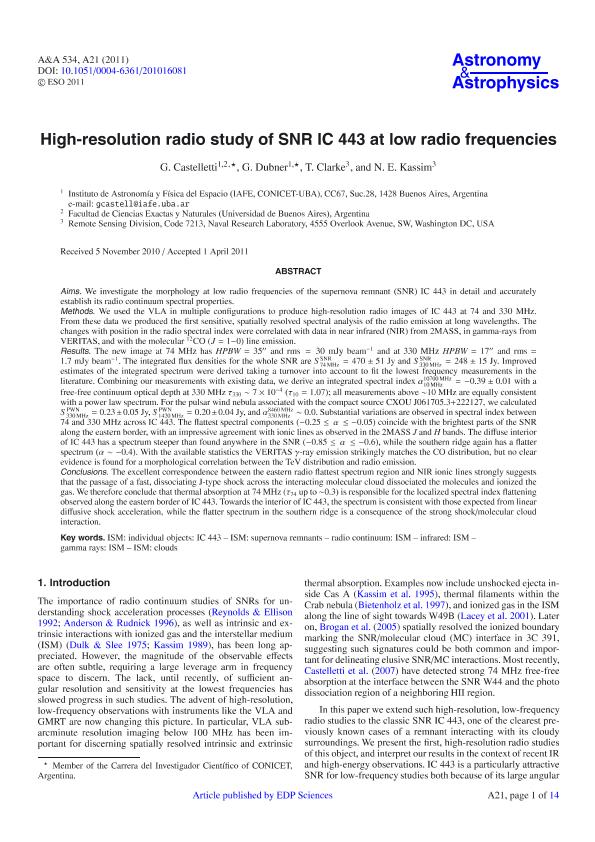Artículo
High-resolution radio study of SNR IC443 at low radio frequencies
Fecha de publicación:
04/2011
Editorial:
EDP Sciences
Revista:
Astronomy and Astrophysics
ISSN:
0004-6361
Idioma:
Inglés
Tipo de recurso:
Artículo publicado
Clasificación temática:
Resumen
Aims. We investigate the morphology at low radio frequencies of the supernova remnant (SNR) IC 443 in detail and accurately establish its radio continuum spectral properties. Methods. We used the VLA in multiple configurations to produce high-resolution radio images of IC 443 at 74 and 330 MHz. From these data we produced the first sensitive, spatially resolved spectral analysis of the radio emission at long wavelengths. The changes with position in the radio spectral index were correlated with data in near infrared (NIR) from 2MASS, in gamma-rays from VERITAS, and with the molecular 12CO (J = 1 − 0) line emission. Results. The new image at 74 MHz has HPBW = 35′′ and rms = 30 mJy beam-1 and at 330 MHz HPBW = 17′′ and rms = 1.7 mJy beam-1. The integrated flux densities for the whole SNR are Jy and Jy. Improved estimates of the integrated spectrum were derived taking a turnover into account to fit the lowest frequency measurements in the literature. Combining our measurements with existing data, we derive an integrated spectral index with a free-free continuum optical depth at 330 MHz τ330 ~ 7 × 10-4 (τ10 = 1.07); all measurements above ~ 10 MHz are equally consistent with a power law spectrum. For the pulsar wind nebula associated with the compact source CXOU J061705.3+222127, we calculated Jy, Jy, and . Substantial variations are observed in spectral index between 74 and 330 MHz across IC 443. The flattest spectral components ( − 0.25 ≤ α ≤ − 0.05) coincide with the brightest parts of the SNR along the eastern border, with an impressive agreement with ionic lines as observed in the 2MASS J and H bands. The diffuse interior of IC 443 has a spectrum steeper than found anywhere in the SNR ( − 0.85 ≤ α ≤ − 0.6), while the southern ridge again has a flatter spectrum (α ~ −0.4). With the available statistics the VERITAS γ-ray emission strikingly matches the CO distribution, but no clear evidence is found for a morphological correlation between the TeV distribution and radio emission. Conclusions. The excellent correspondence between the eastern radio flattest spectrum region and NIR ionic lines strongly suggests that the passage of a fast, dissociating J-type shock across the interacting molecular cloud dissociated the molecules and ionized the gas. We therefore conclude that thermal absorption at 74 MHz (τ74 up to ~0.3) is responsible for the localized spectral index flattening observed along the eastern border of IC 443. Towards the interior of IC 443, the spectrum is consistent with those expected from linear diffusive shock acceleration, while the flatter spectrum in the southern ridge is a consequence of the strong shock/molecular cloud interaction.
Archivos asociados
Licencia
Identificadores
Colecciones
Articulos(IAFE)
Articulos de INST.DE ASTRONOMIA Y FISICA DEL ESPACIO(I)
Articulos de INST.DE ASTRONOMIA Y FISICA DEL ESPACIO(I)
Citación
Castelletti, Gabriela Marta; Dubner, Gloria Mabel; Clarke, T.; Kassim, N. E.; High-resolution radio study of SNR IC443 at low radio frequencies; EDP Sciences; Astronomy and Astrophysics; 534; A21; 4-2011; 1-14
Compartir
Altmétricas




